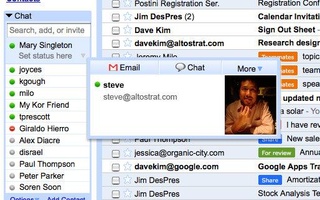In the three weeks since Google began hosting @college webmail accounts, 98 percent of the 5,610 students using @college email addresses made the switch.
With the exception of a few security breaches, most students reported successful shifts to the new email client.
The switch to Google’s Gmail email client was done in tandem with the merger of two Harvard information technology departments into one unit, Harvard University Information Technology.
That organization, founded June 15, united Faculty of Arts and Sciences IT with University Information Systems, bringing together over 450 Harvard staff members.
According to administrators within HUIT, the synergy between the members of the new organization facilitated the email shift.
“The combination of expertise and bench strength allowed us to make the change from one email platform to another in an incredibly short time-frame and without problems,” IT spokesperson Sarah F. O’Connell said.
In particular, O’Connell noted that the team prioritized efficiency in the process.
In mid-May, FAS IT and UIS still served as independent bodies, but together they began examining the new infrastructure for @college email.
Administrators formally decided to make the shift on June 9, hoping to get the new system in place before students returned to campus in late August.
This short time-frame required “all hands on deck” according to O’Connell, who said that HUIT even decided to put some undisclosed projects on hold.
“We are pleased to hear that this is making it easier for students to do their work,” she said.
The new infrastructure replaces the former @college webmail client, Mail2World.
While often criticized by students for being clunky and difficult to use, Mail2World, a Los Angeles-based company that the College turned to two years ago, was never meant to be a temporary fix, HUIT officials said.
In fact, Harvard considered Google when it created @college email accounts but opted for Mail2World instead.
“At the time, it was determined to be the solution that best met all of our requirements, which Google did not,” O’Connell said.
Read more in News
Budget Relief as Endowment IncreasesRecommended Articles
-
 Harvard College To Switch Email Provider To Gmail
Harvard College To Switch Email Provider To Gmail -
 How the Gmail Change Affects Seniors
How the Gmail Change Affects Seniors -
Faculty Cancel Controversial Summer School Instructor's Courses, Debate Reaction to 'Occupy'At Tuesday's Faculty Meeting, faculty members challenged the University's response to Occupy Harvard and voted to remove two summer economics courses taught by controversial Indian politician Subramanian Swamy from the course catalog.
-
HUIT Unification ContinuesNearly a dozen unification projects are still in the works nine months after Harvard announced the creation of Harvard University Information Technology and are projected for completion by the end of this academic year, according to Anne H. Margulies, University chief information officer.
-
HUIT To Improve WiFi Coverage on CampusIn an effort to improve wireless internet access in some of the campus’ weakest hot spots, Harvard University Information Technology will install a new wireless core and 4,000 wireless access points by September.
-
HUIT Considers Student Input for Web MakeoverStarting Wednesday, students will be able to submit designs for the new face of my.harvard.edu to the Harvard Student Information Technology Advisory Committee.













